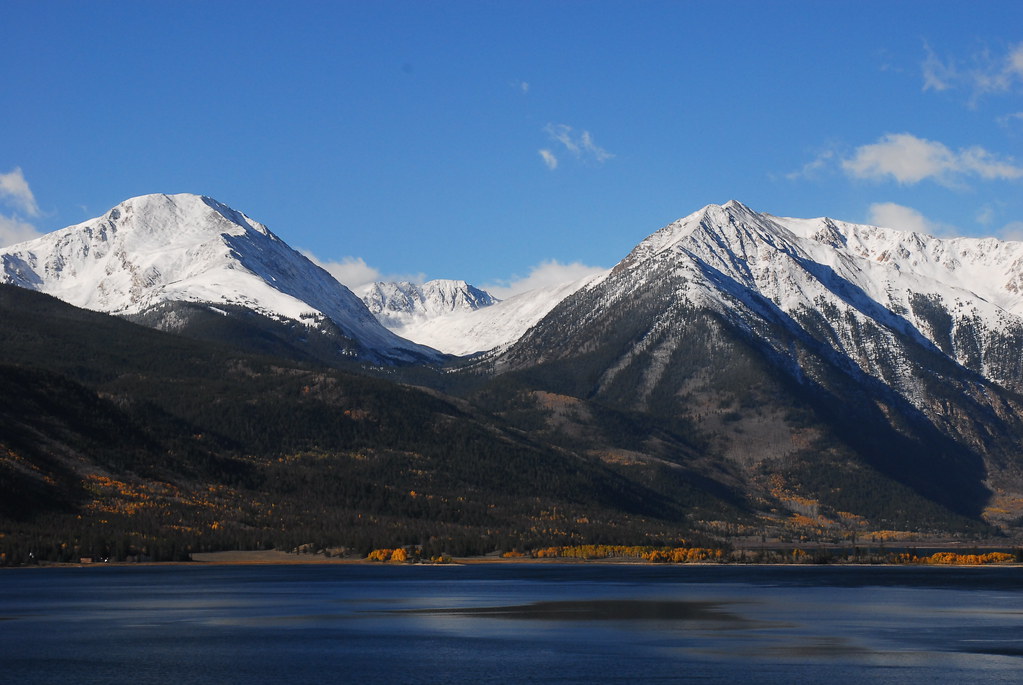
Twin Lakes, Colorado :: Photo by Alex
Cindy left a link in a comment to this article in the New York Times.
I haven't read the entire article yet, it's a long one. It appears to be focused on the Southwest and the West and the Colorado River. I have been painfully aware of water resource issues for many years. Water and water rights were in the news almost daily when I lived in Aspen, where all the water is headed downstream a short distance to the Colorado.
THE FRYING PAN-ARKANSAS PROJECT ::
Up in the mountains above Aspen, much of the water (mostly from snowmelt) is diverted over the mountains and through the woods to the Front Range of southeastern Colorado - Colorado Springs and Pueblo. The Frying Pan-Arkansas (the Frying Pan River is just over the ridge from Aspen, and is a Gold Medal fly fishing stream - it runs through Basalt - the Arkansas River is just over the continental divide east of Aspen) Project involves 26 miles of tunnels and 281 miles of conduit and siphons. Reservoirs include Ruedi (on the Frying Pan), Twin Lakes, Turquoise Lake, and Pueblo.
It also involves seventeen "diversion dams" or structures, on the rivers around Aspen. These structures basically suck, or divert water from the river into conduits (pipes), flumes or canals, which are all then fed to the storage reservoirs.
Needless to say it's a huge project, and includes two hydroelectric power plants - Otero and Twin Lakes/Mt. Elbert which is rated at 200 MegaWatts.
Note that the U.S. Bureau of Reclamation is the developing/managing entity when it comes to fresh water resources.
Here's a Wikipedia link.
COLORADO-BIG THOMPSON PROJECT ::
This diversion project takes water from the headwaters of the Colorado and Big Thompson Rivers and diverts it to the northern Front Range cities of Denver, Ft. Collins, Boulder, etc.
THE ANIMAS-LA PLATA PROJECT ::
Down in southwestern Colorado (near Durango) on the Animas River is the Animas-La Plata Project. I spent my summers in high school backpacking and mountain climbing in the Weminuche Wilderness - the Needles and the Grenadiers Ranges. We would get there by taking the narrow gauge railroad along the Animas River.
This one has been controversial, and is still under construction. The reservoir is slated to be filled in 2009. Water supplies will largely go to the Navajo Nation in the Four Corners area.
These are huge projects that redistribute surface water, largely from snowmelt for municipal use (your tap water, watering your yard and your golf course, and washing your car) and agricultural (irrigation) uses. This is just the state of Colorado. All of the other Rocky Mountain states have similar projects to capture the snowmelt and send it downstream, and not let it just seep into the ground.
One thing that comes to mind, the Roaring Fork River (in Aspen) dries to almost a trickle in August and September each year.
The rivers where this water goes are the Platte (Nebraska) and the Arkansas (Kansas) to the east, the Rio Grande to the south (New Mexico, Texas and Mexico), and the Colorado to the west (Utah, Nevada, California). The Colorado, again, is the focus of the NYT article.
Water resource issues are not limited to the westerns states alone. Remember the drought in Georgia being in the news this year, and the fear that Atlanta would completely run out of fresh water supplies?
There are issues with overdrafting of major aquifers - the Floridan aquifer, the Edwards aquifer (Texas and my post on "The Unforeseen"), and the Oglalla aquifer, "one of the world's largest", which stretches north-south from the west Texas plains to South Dakota.
Overdrafting of the aquifer beneath Palm Springs, California is causing ground subsidence. There are roughly 120 golf courses in the Palm Springs area. I'm not sure, but I think there is a tie between the aquifer beneath Palm Springs and the Colorado River.
What's the point of all this? The point of this post, besides being "educational"? It's that water, like oil, is a fixed and finite resource. There is not more water that's going to miraculously appear from somewhere - unless it's in the form of higher sea levels as the polar ice caps melt due to global warming - if you believe the worst case scenario of that theory.
It may manifest itself in that the American dream of the irrigated, green, lush lawn (with the white picket fence) may go by the wayside. Washing the car in the driveway. Taking a shower every day or even twice a day. American luxuries based on the affluenza mindset. How would you feel about buying a brand new house that didn't have any grass? Where's the dog going to take his morning dump?
Too many people, too much development/sprawl, not enough water to go around. Another delicate resource we take for granted. Turn on the tap and it's there. Right?
Don't even get me started on water "quality" issues. I used to build water and wastewater treatment plants. I wouldn't want to scare you.
RESOURCES ::
Here's a link to a household water budget worksheet.

2 comments:
I would be in a perpetual state of outrage if these stories were all I read, Alex. Mercifully, there IS good news in the world as well. I get my daily dose at Gimundo.com.
Breathtaking picture above, BTW.
Yes, it is amazing what they are doing to Colorado's water. Sending it across the divide to feed the growing front range, creating more high altitude reservoirs to prepare for the dry years, etc. Many of the mountain rivers are changing ecologically because of our insatiable desire to water our lawns. It is a sad tale...
Post a Comment